Microsoft Windows is a product line of proprietary graphical operating systems developed and marketed by Microsoft. It is grouped into families and sub-families that cater to particular sectors of the computing industry -- Windows (unqualified) for a consumer or corporate workstation, Windows Server for a server and Windows IoT for an embedded system. Defunct families include Windows 9x, Windows Mobile, Windows Phone, and Windows Embedded Compact.

QNX is a commercial Unix-like real-time operating system, aimed primarily at the embedded systems market.

A Pocket PC is a class of personal digital assistant (PDA) that runs the Windows Mobile or Windows Embedded Compact operating system that has some of the abilities of modern desktop PCs. The name was introduced by Microsoft in 2000 as a rebranding of the Palm-size PC category. Some of these devices also had integrated phone and data capabilities, which were called Pocket PC Phone Edition. Windows "Smartphone" is another Windows CE based platform for non-touch flip phones or dumber phones.
Windows Embedded Compact, formerly Windows Embedded CE, Windows Powered and Windows CE, is a discontinued operating system developed by Microsoft for mobile and embedded devices. It was part of the Windows Embedded family and served as the foundation of several classes of devices including the Handheld PC, Pocket PC, Auto PC, Windows Mobile, Windows Phone 7 and others.

Windows Mobile is a discontinued mobile operating system developed by Microsoft for smartphones and personal digital assistants.

ActiveSync is a mobile data synchronization app developed by Microsoft, originally released in 1996. It synchronizes data with handheld devices and desktop computers.

A handheld personal computer (PC), typically built around either a clamshell form factor or a gaming form factor with a gamepad integrated for video games, is a mobile device that is significantly smaller than any standard personal computer (PC), but based on the same principles as PCs. The clamshell form factor is sometimes referred to as a palmtop computer, not to be confused with Palmtop PC which was a name used mainly by Hewlett-Packard.
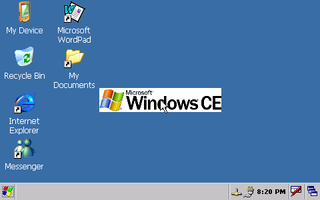
Windows CE 5.0 is a successor to Windows CE 4.2, the third release in the Windows CE .NET family. It was first released on July 9, 2004. Like its predecessors, Windows CE 5.0 is marketed towards the embedded device market and independent device vendors. Windows CE 5.0 is billed as a low-cost, compact, fast-to-market, real-time operating system available for x86, ARM, MIPS, and SuperH microprocessor-based systems.
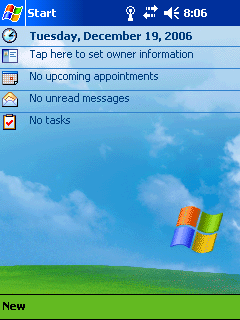
Windows Mobile 2003, originally codenamed "Ozone", was a member of the Windows Mobile family of mobile operating systems, released on June 23, 2003. It was the first Microsoft mobile OS to be called "Windows Mobile" and was based on Windows CE 4.20.
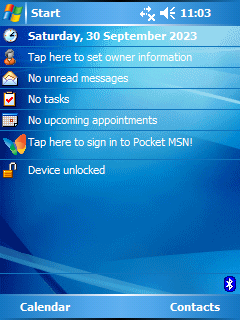
Windows Mobile 5.0, originally codenamed "Magneto", was released at Microsoft's Mobile and Embedded Developers Conference 2005 in Las Vegas, May 9–12, 2005. Microsoft offered mainstream support for Windows Mobile 5 through October 12, 2010, and extended support through October 13, 2015. It was first offered on the Dell Axim x51. It used the .NET Compact Framework 1.0 SP3, an environment for programs based on .NET. Windows Mobile 5.0 included Microsoft Exchange Server "push" functionality improvements that worked with Exchange 2003 SP2. The "push" functionality also required vendor/device support With AKU2 software upgrades all WM 5.0 devices supported DirectPush. This version featured increased battery life due to Persistent storage capability. Previously up to 50% of battery power was reserved just to maintain data in volatile RAM. This continued the trend of Windows-based devices moving from using RAM as their primary storage medium to the use of a combination of RAM and flash memory. Programs and frequently accessed data run in RAM, while most storage is in the flash memory. The OS seamlessly moves data between the two as needed. Everything is backed up in the flash memory, so unlike prior devices, WM5 devices lose no data if power is lost. New to 5.0, OS updates were released as Adaptation kit upgrades, with AKU 3.5 being the final released.
A Bluetooth stack is software that is an implementation of the Bluetooth protocol stack.

Windows IoT, short for Windows Internet of Things and formerly known as Windows Embedded, is a family of operating systems from Microsoft designed for use in embedded systems. Microsoft has three different subfamilies of operating systems for embedded devices targeting a wide market, ranging from small-footprint, real-time devices to point of sale (POS) devices like kiosks. Windows Embedded operating systems are available to original equipment manufacturers (OEMs), who make it available to end users preloaded with their hardware, in addition to volume license customers in some cases.

Windows Mobile 6, formerly codenamed "Crossbow", was the version of Windows Mobile released on February 12, 2007 at the 3GSM World Congress 2007. It comes in three different versions: "Windows Mobile 6 Standard" for Smartphones, "Windows Mobile 6 Professional" for Pocket PCs with phone functionality, and "Windows Mobile 6 Classic" for Pocket PCs without cellular radios.
Microsoft Windows is the name of several families of computer software operating systems created by Microsoft. Microsoft first introduced an operating environment named Windows in November 1985 as an add-on to MS-DOS in response to the growing interest in graphical user interfaces (GUIs).
Ford Sync is a factory-installed, integrated in-vehicle communications and entertainment system that allows users to make hands-free telephone calls, control music and perform other functions with the use of voice commands. The system consists of applications and user interfaces developed by Ford and other third-party developers. The first two generations run on the Windows Embedded Automotive operating system designed by Microsoft, while the third and fourth generations runs on the QNX operating system from BlackBerry Limited. Future versions will run on the Android operating system from Google.
Microsoft SQL Server Compact is a discontinued relational database produced by Microsoft for applications that run on mobile devices and desktops. Prior to the introduction of the desktop platform, it was known as SQL Server for Windows CE and SQL Server Mobile Edition.
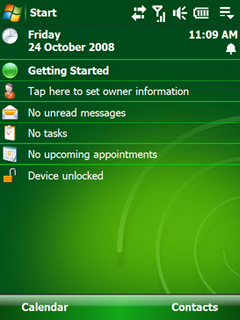
Windows Mobile 6.1 was a version of the Windows Mobile operating system, released on April 1, 2008. It is a minor upgrade to the Windows Mobile 6 platform with various performance enhancements and a redesigned Home screen featuring horizontal tiles that expand on clicking to display more information, although this new home screen is featured only on Windows Mobile Standard edition. This was not supported in the Professional edition. Several other changes such as threaded SMS, full page zooming in Internet Explorer and 'Domain Enroll' were also added, along with a "mobile" version of the Microsoft OneNote program and an interactive "Getting Started" wizard. Domain Enroll is functionality to connect the device to System Center Mobile Device Manager 2008, a product to manage mobile devices. The most apparent of the other differences is that the Standard version still creates automatic links for telephone numbers in Tasks and Appointments, which allows for the easier click and dial of stored telephone numbers within these Outlook items. This feature is not supported in the Professional version. Windows Mobile 6.1 also had improved bandwidth efficiency in its push-email protocol "Activesync" of "up to 40.02%"; this considerably improved battery life in many devices.

A carputer, or car-puter, is a computer with specializations to run in a car, such as compact size, low power requirement, and some customized components. The computing hardware is typically based on standard PCs or mobile devices. They normally have standard interfaces such as Bluetooth, USB, and WiFi. The first carputer was introduced by Clarion on December 4, 1998, although on-board diagnostics have been employed since the 1980s to precisely measure the amount of fuel entering the engine as the carburetors got too complex.
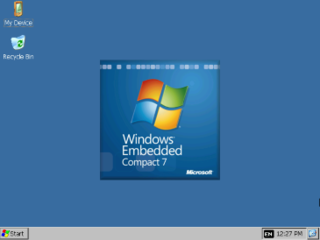
Windows Embedded Compact 7 is the seventh major release of the Windows Embedded CE operating system, released on March 1, 2011. Windows Embedded Compact 7 is a real-time OS, separate from the Windows NT line, and is designed to target enterprise specific tools such as industrial controllers and consumer electronics devices such as digital cameras, GPS systems and also automotive infotainment systems. Windows Embedded Compact is designed to run on multiple CPU architectures and supports x86, SH and ARM.

Tuxera Inc. is a Finnish company that develops and sells file systems, flash management and networking software. The company was founded in 2008 and is headquartered in Espoo, Finland. Tuxera's other offices are located in the US, South Korea, Japan, Hungary, Germany, Taiwan and China.












